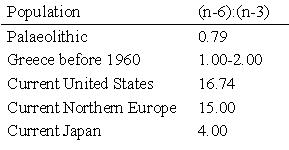There are two fatty acids essential to human health. Alpha-linolenic acid belongs to the omega 3 family of fatty acids and linoleic acid belongs to the omega 6 family of fatty acids. Both fatty acids are essential to health, and as with vitamins and minerals, they are needed in the correct amounts. Essential fats are generally not used for energy, but instead converted to a number of short lived hormones called eicosanoids (here). Eicosanoids can be both beneficial or harmful to health depending on the exact hormone that predominates, and this in turn is related to the ratio of omega 6 to omega 3 fats in the diet of the individual. A high omega 6 to omega 3 ratio tends to produce pro‑inflammatory eicosanoids and result in the formation of degenerative diseases like cancer, heart disease and diabetes.
Evidence suggests that over time, the omega 6 to omega 3 ratio of our diets has increased, and this is a leading cause of the degenerative diseases that are now prevalent in the West. In Palaeolithic times the ratio of omega 6 to omega 3 fatty acids in the human diet has been estimated at 0.79. In contrast, currently in Northern Europe and the United States the ratio of omega 6 to omega 3 fatty acids might be as high as 15 or 16 respectively (figure 1). Current recommendations are to eat more omega 3 fatty acids and less omega 6 fatty acids in order to try to decrease the prevalence of the pro‑inflammatory eicosanoids. However, researchers are unsure about the exact ratio of omega fatty acids required to achieve the correct balance of eicosanoids.
 Figure 1. The ratio of omega 3 (n-3) to omega 6 (n-6) in various diets1.
Figure 1. The ratio of omega 3 (n-3) to omega 6 (n-6) in various diets1.
Epidemiological evidence suggests that the Japanese are protected from certain diseases because they have an omega 6 to omega 3 ratio of around 4. The Mediterranean diet is also protective of degenerative disease and this diet has an omega 6 to omega 3 ratio of around 2. Both of these diets have low ratio numbers because they are high in oily fish. Oily fish contains the omega 3 fatty acid eicosapentanoic acid, which is a metabolite of alpha linolenic acid in human eicosanoid production. Increasing omega 3 fatty acids in the diet may provide health benefits seen in the Japanese and Mediterranean diets. Eating more oily fish; or consuming walnuts, flax seeds and hemp seeds (or their oils) are good ways of increasing the dietary levels of the omega 3 fats eicosapentanoic acid and alphalinoleic acid, respectively.
RdB
